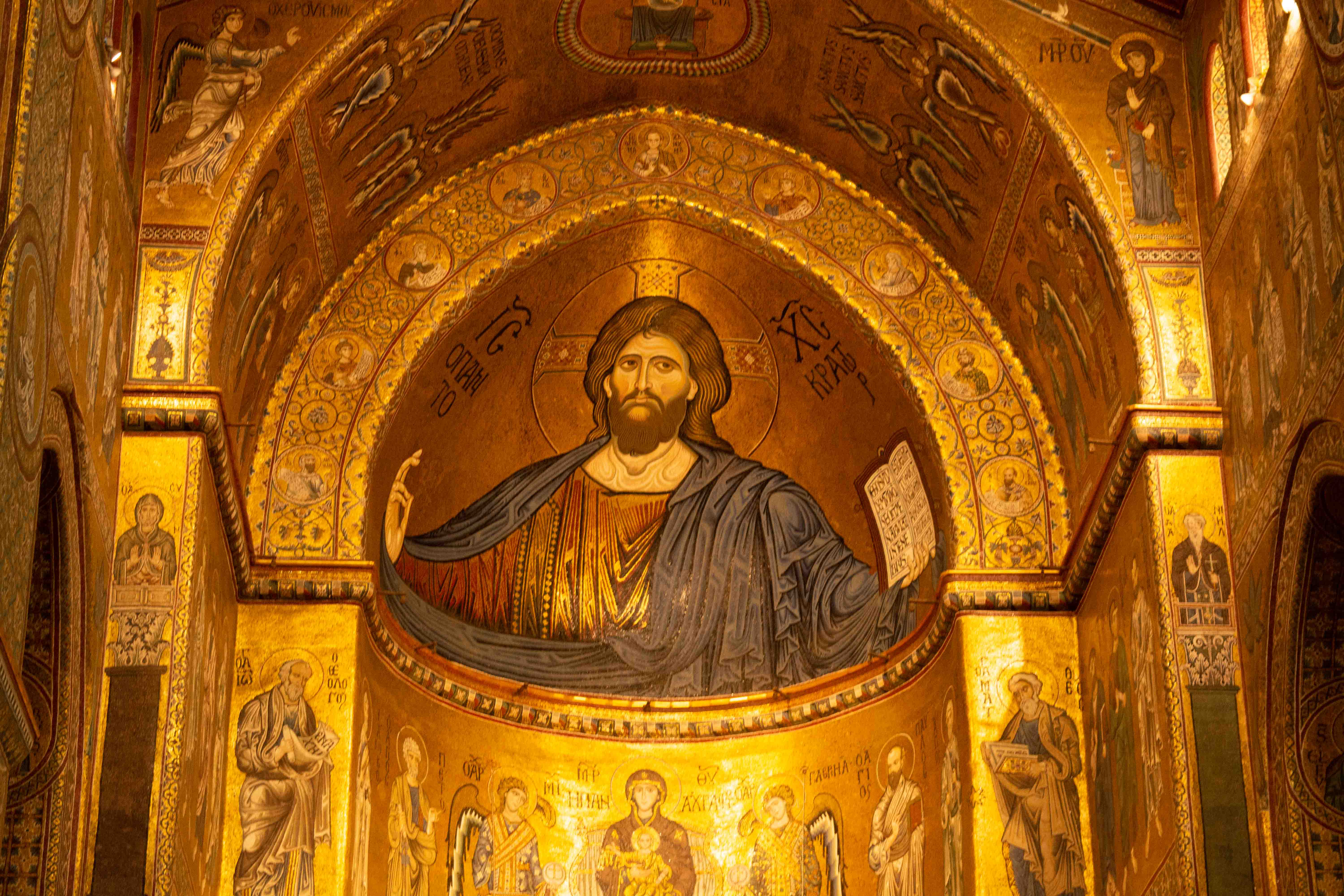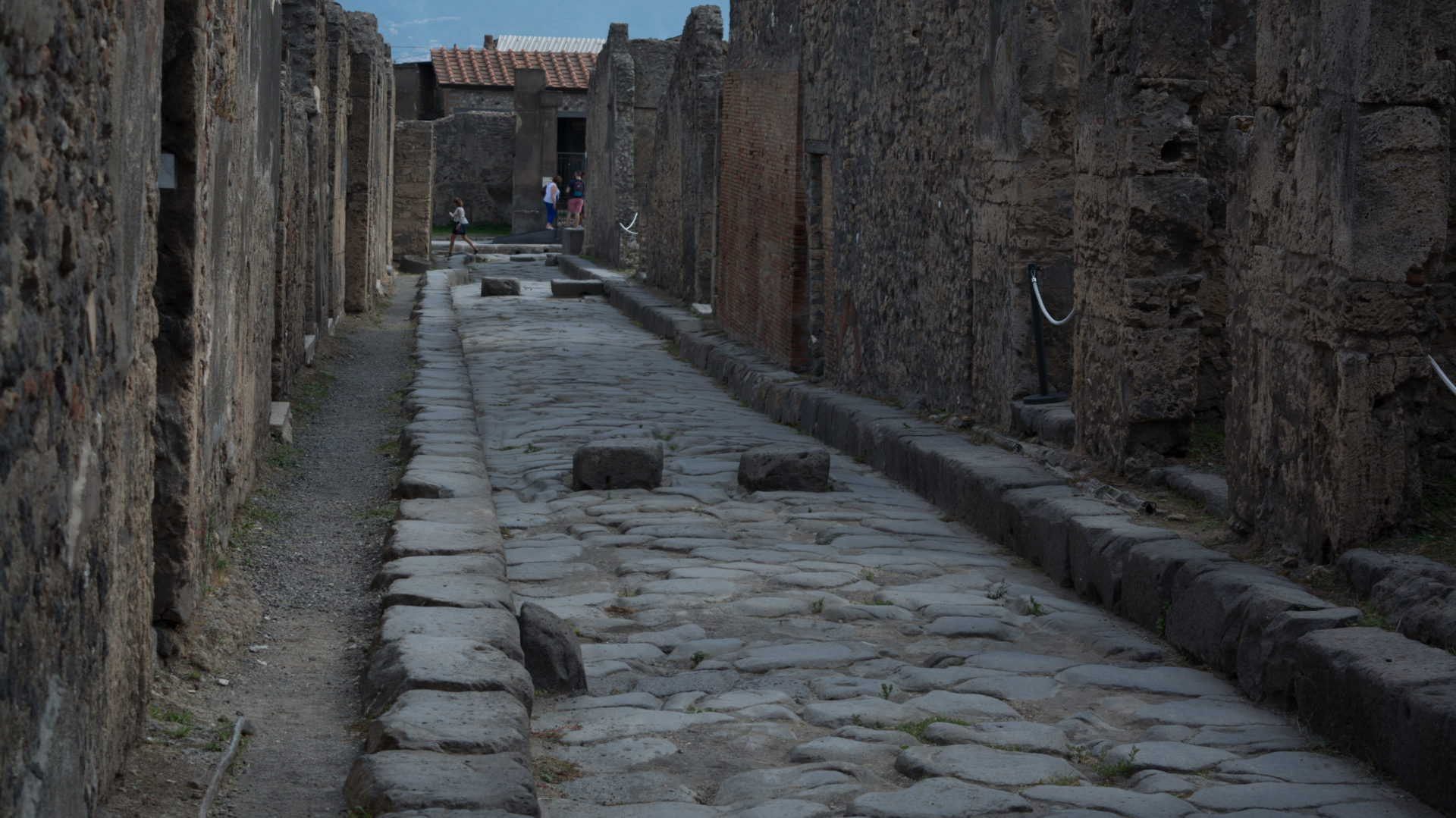Our first day in Sicily began in the city of Palermo, where we had arrived the night before. Originally founded in the 700s BC by the Phoenicians (who also gave us one of the world’s earliest alphabets) the city was originally known as Ziz. It changed hands multiple times over the centuries. It was a very important city for the Carthaginians, longtime rivals of the Greeks and Romans, and was conquered by Rome during the Punic Wars. After passing briefly into Barbarian and then Byzantine hands, the city was made the island’s capital in the 9th century by the conquering Arabs. After being re-conquered by the Normans in the 11th century, the city was then to experience a brief Golden Age. Our travels on Day 1 focused largely on the Normans and the great monuments they built here in Palermo.
The Normans are so named because they had their origins in northern France, specifically the seaside region known as Normandy. This is the same region where the famous D-Day landings of June 6th, 1944 took place. Among the Norman forces conquering Sicily at this time were 6 members of a prominent family by the last name of Hauteville. There were 12 sons in this family, and 6 of them came here to Sicily. They would go on to form a Kingdom which lasted for around 130 years. The rulers of that kingdom are easy to remember: Roger I, Roger II, William I, and William II. Never actually crowned King, Roger I did much to unite the separate parts of Sicily and the surrounding areas. After his death, his son Roger II was crowned as Sicily’s first King in 1130. Having inherited an island with a complex history and diverse heritage, Roger II used these already-existing influences to create a unique architectural style in the monuments he built. His sons and heirs would imitate that style in their own monuments as well, producing an architectural legacy as unique and varied as Sicily itself.
Our first stop was the Cathedral of Monreale, built in 1174 by William II (also known as William the Good). The two towers overlooking the plaza were originally the same height, but one tower was shortened after being struck by lightning in 1807:

The interior is a true wonder to behold. The mosaics shine with gold and recount stories from the Old and New Testaments:

The original ceiling was, unfortunately, destroyed by a fire in the 1800s, so the one you see here is a replica:

Scenes from the lives of the Saints are also illustrated on the walls of the Cathedral. Here is a depiction of the crucifixion of Peter:

William I and William II are both buried here. This large purple sarcophagus belongs to William I, also known as “William the Bad.” With three elder brothers ahead of him, William I was never expected to take the throne. The unfortunate and untimely deaths of all three of them surprised everyone, William included. He was thus poorly prepared for the burdens and responsibilities of ruling when he was crowned King in 1154:

Next to William I is his son and heir William II, also known as “William the Good.” Made a boy-king at age 12 by the death of his father, William was inspired by the architectural works of his grandfather Roger II. His monumental legacy is thus modeled on earlier works of Roger II’s distinctive style. Having no children when he died in 1189, William II was the last Norman ruler of Sicily. The sarcophagus you see here is a replacement for his original, and it was last opened in the 1800s after the fire:

William II also appears in Dante’s Divine Comedy, where he resides in paradise.
Given the island’s strong Christian influence, it was very important for William II to demonstrate that God supported his kingship. He knew that the people of the island would not tolerate a King who was out of touch with God. Thus there are two mosaics in the Cathedral that serve this purpose. In this mosaic, the crown is being placed on William’s head by Christ:

Directly across from it, this mosaic displays William presenting the finished Cathedral to the Blessed Virgin Mary:

At the very front of the Cathedral, high above the altar, is the image of Christ Pantocrator. As pleased as I am with this picture, I have to admit that it does the mosaic no justice. In person it is absolutely breathtaking:

And of course Christ makes many more appearances throughout the mosaics in the Cathedral, including this one on a section of ceiling:

After taking our time marveling at the interior, we proceeded up a narrow staircase towards the roof. Along the way we walked along a catwalk above the cloisters below:

Upon reaching the roof we could see the entire town of Palermo stretched out below us. The bay is visible in the distance:

The cathedral is built with a mixture of local yellow limestone and black volcanic rock from Mount Etna. The difference between the two types of stone is easy to see here:

At the front of the Cathedral, these great bronze doors are original and were first installed in 1186:

Heading into the cloisters at ground level, we found a courtyard surrounded by pairs of columns. Each column has a ribbon of glass mosaics wrapped around it, and no two of them are alike:

This pair has fallen apart in a way that makes it easy to see how the mosaics were applied to the columns:

As we walked around the courtyard, I happened to notice that the columns and arches perfectly framed this shot of the Norman Cathedral towing high above:

After finishing up at the cathedral we headed back into Palermo and stopped at the Paolo Orsi Archaeological museum. This museum prepared us for some of the Greek temples we would see later in the week. This tabletop model of a Greek temple provides a good preview of how some of them look today:

Denise explained that the temples would at one time have been painted bright colors. Back in Greece the temples were covered with marble, but since there is no marble here in Sicily they would have covered them with white plaster. Parts of the temple would also have had brightly colored patterns on them, such as the ones seen here:

In the same room were three metopes that once decorated the outside of Temple C in Selinus. We saw this temple later in the trip, and it will be shown in a later post. The temple was built in the 6th century BC. All of the metopes show scenes from Greek mythology. Here is the Chariot of the Sun:

This one shows Perseus cutting the head off of Medusa. The Greeks were being influenced by Egyptian artists at this time, notice how the figures appear blocky and the feet face straight to the right:

This one shows Heracles and two smaller creatures called Cercopes. Once again, notice how his feet face straight to the right just like in Egyptian art:

On another wall in the same room were 4 metopes from Temple E, which was also located in the city of Selinus but was built later than Temple E (at around 480BC). Notice how the artistry is a bit more advanced only 1 century later.
Here is Heracles seizing the belt of the Amazon:

Hera’s wedding to Zeus:

Artemis and the hunter:

This close-up of the dog’s mouth shows the extent of the detail the artists were able to produce even at this very early time:

Denise explained that the ruins of these two temples provided us with some of the first hard evidence that Greek temples were painted. This piece has traces of red, white, and blue paint still on it:

This illustration inside the museum gives a good idea of what a freshly painted temple would have looked like:

While wandering about the museum I noticed this ancient vessel which was clearly made by hand. I set out to find some fingerprints on it from two-and-a-half millennia ago, and indeed they were there:


The Greek pottery in this museum was impressive, but not nearly as impressive as what we would see later in the tour:

On our walk back to the hotel we stopped by this Arabic-looking chapel to have a look inside. This is an excellent example of the unique blending of styles that exists here in Sicily:

And beneath it was a section of the ancient city wall, laid down long ago when Palermo still belonged to Carthage:

Our evening included special access to the Cappella Palatina, the church built by Roger II in 1132. Accompanied by local staff and guides, we were free to explore the chapel on our own. It is easy to see why William II wanted to imitate this chapel when he built the Cathedral. The mosaics and the architecture are truly breathtaking!
At the rear of the chapel Christ sits on the throne, flanked by Saints Peter and Paul:

The gleaming candle-lit gold is an incredible sight. Just like in the Cathedral, the image of Christ Pantocrator watches from high above the altar:

The original wooden ceiling, still in place, is an Arabic-style stalactite formation. Elaborately carved and with sections seeming to float in midair, every last facet is meticulously painted:

Just like in the Cathedral, images of prophets and saints are scattered all around the interior. Also on display is an assortment of Latin and Greek writing, another sign of the unique and diverse culture that Roger II ruled over:

After leaving the Cappella Palatina we went back to the hotel for a late dinner. Tomorrow morning we would need to get up early to start making our way to Agrigento.
That was the end of Day 1! In my next post I will cover Day 2, when we visited the cities of Segesta and Selinus, ancient rivals whose constant military contests left a permanent mark on history. Check back soon for more!
